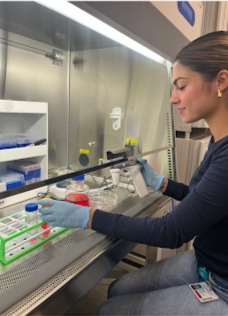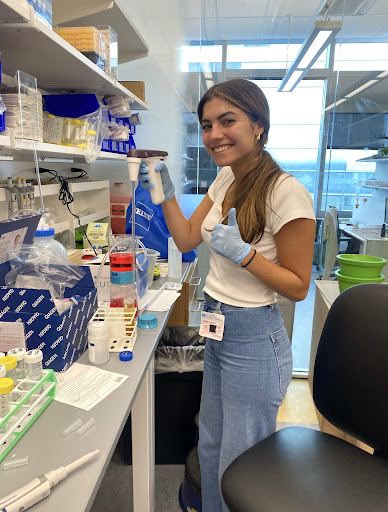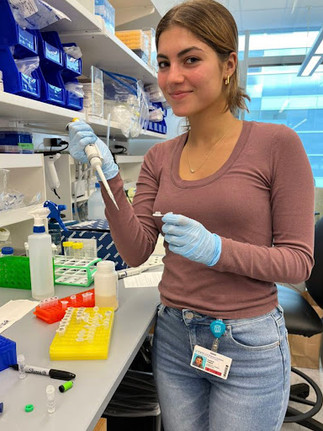
For as long as I could remember, I have been fascinated by the brain. So, I was so excited to intern at The Wheeler Lab in the Ann Romney Center for Neurologic Diseases at Brigham and Women’s Hospital this summer. The Wheeler Lab studies neuroimmunology with a focus on integrating genomics, neurology, and immunology. During my time in the lab, I had the opportunity to work under Dr. Michael Wheeler and Lizzie Chung, a research technician. This unique opportunity provided me with great insight and experience in a lab environment.
During the first week of my internship, I began learning laboratory skills that I used through the duration of my work, studying models of depression and anxiety in mice. I helped produce Adeno-associated Viruses which were used for CRISPR knockouts to inject into the amygdala, the brain region responsible for fear, of mice. This process deleted certain genes to study how specific genes affect depression and anxiety. In addition, I learned to isolate neurons from the amygdala of mice to use for RNA- and ATAC- seq to understand how chromatin modifications and transcription factors impact gene expression. I also learned how to passage Human Embryonic Kidney Cells and to clone and perform transformations into E. coli competent cells.
During my internship, I helped with a project to determine if specific mouse phenotypes result from deleted genes produced by the CRISPR knockouts or from depression, anxiety, and stress. This project required daily behavior assays for a week; the test included a stress group and unstressed (control) group of mice. Once the week of tests were completed, we performed contextual fear conditioning for four days. During this process, we created an environment with black walls and a banana scent for the first day of conditioning. The environment for the subsequent days of this experiment was altered and had white walls with a lemon scent. This change helped us see if the mice could extinguish fear in different environments and dissociate a fear response from the environment. We recorded how the mice reacted to this environment to capture and find certain phenotypes. Then, we isolated their neurons from the amygdala and ran the ChIP- seq protocol to further understand transcription factors. This work will lead the lab to identify specific transcription factors that regulate genes, impairing the fear responses of mice.

I also helped another research trainee perform behavioral assays on mice for a 30-day period. This experiment was intended to model depression in mice and studied how treatment with broad-spectrum antibiotics, which causes depletion of the gut microbiome, correlates to depression and anxiety. Half of the mice drank water containing a mixture of different antibiotics while the other half of mice drank water with saccharin as a control; the antibiotics altered the mice’s microbiomes. The experiment induced depression in the mice by causing stress. There were three different categories of stress for the mice in the experiment, each with antibiotic and saccharin mice. There were mice that were stressed daily for four minutes, mice that were stressed once daily but had a path to escape, and mice that did not endure stress which served as the control. The lab conducted further experiments to measure how depressed the mice were. The lab will use this data to study how microbiome metabolites affect stress-induced depression by regulating the immune response and neural circuits.
Additionally, I collected stool every week from each of the mouse cages to measure and study how the antibiotic and saccharin (no antibiotic) mouse microbiomes were affected. We performed a protocol to extract DNA from the stool; then, we used a NanoDrop which analyzes the DNA concentration.
Overall, I learned laboratory skills and how to perform many experiments while also learning critical lessons of science. By attending weekly lab meetings, I saw how scientists work together by discussing and building on each other's ideas and individual projects. These meetings also provided me with an insight on how to present scientific research and data. Furthermore, I read several scientific articles and journals relating to the research I contributed to. Although some of the language was unfamiliar to me and often complex, I became more comfortable with it over time and found a deep interest in the articles. I am grateful for my experience in The Wheeler Lab as I learned a great amount about research and realized that I hope to continue contributing to research and an education in neuroscience. I would like to thank Dr. Wheeler and Lizzie for being so welcoming and open to teaching me about their work. Additionally, I am grateful for Rivers and Mr. Schlenker’s work to make this amazing opportunity possible.










Comments